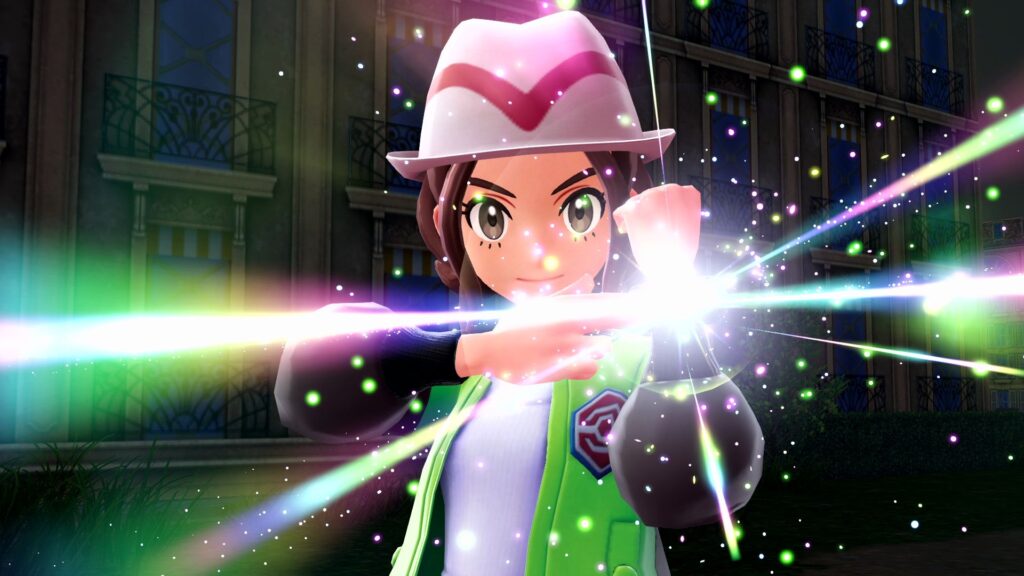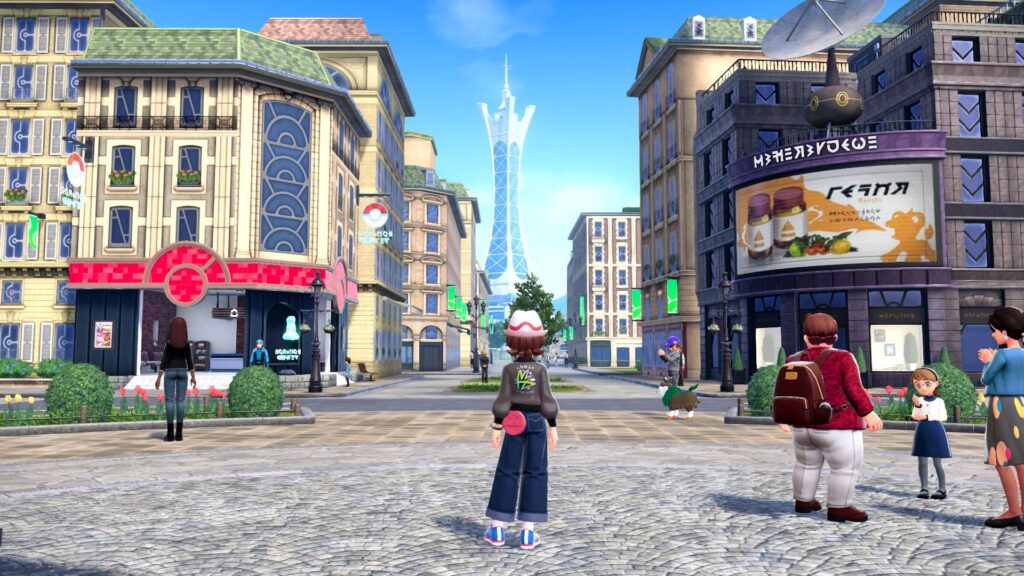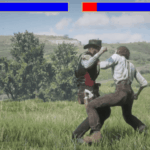Pokemon has had a bit of a rough time in the Switch era, with multiple disappointing entries lacking content, functionality, and a baseline level of quality with multiple flagship products. Arguably the lone exception to this trend was 2022’s Pokemon Legends: Arceus, an open world action RPG spin-off developed by series developer Game Freak which reinvented the entire conceit and gameplay loop for the franchise from the ground up – to fascinating and mostly incredible results. Pokemon Legends: Arceus instantly established itself as a fan favorite, and showed an increasingly disillusioned fanbase that the series could still deliver excellent outings and experiences.
Game Freak should be given credit for not taking the safe route for following up on Legends Arceus’ success. It would have been all too easy to take that game, put it in a new region, with new maps, new biomes, and different Pokemon to catch, while making the requisite amount of polish and UX improvements.
“The decision to set the game in its entirety in just Lumiose City immediately sets this game apart from its predecessor.”
Fans had already responded positively to the premise, why not give them more of that? Instead, however, it seems like Game Freak views the “Legends” subseries as a sandbox to experiment and try new things – because with very few exceptions, almost nothing from Legends Arceus made it into Legends ZA. For good and for bad, this game is entirely its own beast, and the only way it can be defined with respect to Arceus is in all the ways that it’s not like it.
That begins from the most obvious, overarching things, and goes all the way down to the smaller details. Take, for instance, the setting – Legends Arceus was a prequel to the entire rest of the series, but Diamond and Pearl in particular, set hundreds of years in the past, in the wilderness of an untamed Sinnoh region before it had been properly settled, and before Pokemon had been tamed or even understood. Pokemon Legends ZA on the other hand is set after 2013’s Pokemon X and Y, and far from being set in the vast wilderness, they are set instead in the entirety of one city.
The decision to set the game in its entirety in just Lumiose City immediately sets this game apart from its predecessor, and indeed, from any other game in the series. Pokemon from the beginning has been about travelling across the land, searching far and wide. It’s about exploration and adventure and discovery – which runs counter to being set entirely in one bustling urban location, surely?
Truthfully, Legends ZA does a fine job of sidestepping this seeming issue. Lumiose is a fairly large city, and Game Freak leans into the mentality almost of playing and exploring and adventuring in a city as a kid – you get to explore back alleys and under the bridges, you get to go up rooftops and explore the scaffolding. There is a surprising amount to explore and discover in Lumiose – the buildings and rooftops connect to each other in unexpected ways, and often lead to very unexpected discoveries.

“It’s all very delightful – there is a childlike sense of wonder and amusement to it all.”
Exploring Lumiose is fun. It’s not fun in the same way as the rest of the series – there is no getting around the repetition inherent to being set in one city only, after all, it’s not like you will come across a volcano biome or a tundra biome in different parts of Lumiose. But there are a lot of hidden nooks and crannies, things that look interesting and then lead you on merry diversions and tangents that see you end up far from where you started. As I said, it really taps into that visceral thrill of exploring your town as a kid – even the most trite and banal things are cool to you when you are doing that, and that’s the exact spirit that ZA channels.
It also leans into the novelty of how Pokemon fit into an urban setting and lifestyle. In back alleys, among the trash cans, you will encounter Trubbish. An ice cream stand might see Vanillice hanging around. Bird Pokemon such as Pidgey, Fletchling, and others can be seen on wires and rooftops. Bugs like Spinarak are hiding up trees.
It’s all very delightful – there is a childlike sense of wonder and amusement to it all. Legends ZA commits to it not just in terms of gameplay either – you can even see it in the set dressing. Machoke are helping with the construction. Scyther can be seen helping hair stylists. This is the exact kind of thing Pokemon fans have been asking for for so long – a true game in the series that fleshes the setting out and shows us how Pokemon and people fit into it. And we get that here, better than the series has ever done it before.
Of course, a single urban environment by definition would not allow for a lot of variety with the kinds of Pokemon you can run across, which wouldn’t work for, well, a Pokemon game. Legends ZA cheats here. Its story premise posits that some unexplained phenomenon seems to be causing a wide scale migration of wild Pokemon into Lumiose – and the city, in an attempt to mitigate the disruption, attempts to set up demarcated “Wild Zones” to contain this influx of wildlife.

“ZA makes for a series first – the first game in the series that completely eschews turn based battles, opting instead for a real time action battle system that is inspired by the Pokemon anime.”
From a gameplay perspective, these “Wild Zones” are basically like the open world maps that you ventured into to catch Pokemon in Legends Arceus. They are, of course, a lot smaller, and by definition, a lot more one note than the varied biomes and maps of that game. But these see you sneaking up on wild Pokemon hanging out and doing their thing, and try to catch and battle them, with different wild areas playing host to different species of Pokemon. The core loop here is very similar to that game, and is still sublime. You still see Pokemon, freely aim and throw Pokeballs at them, try to stay unnoticed, and engage in battles as and when necessary.
ZA, in fact, makes improvements to the loop here. These range from minor – such as UI improvements – to the major, such as getting the chance to catch a Pokemon even after it has “fainted”, something that no other mainline game in the series has allowed. This is honestly one of the parts the game is best at – the thrill of being able to hunt and catch Pokemon, expanding your Pokédex, the thrill of finding a new or unexpected creature, or a move you are unfamiliar with. ZA keeps this part as compelling as it was before.
Where things are different are in how Pokemon battles go. ZA makes for a series first – the first game in the series that completely eschews turn based battles, opting instead for a real time action battle system that is inspired by the Pokemon anime. Rather than battles seeing you and your opponent take turns, you can use attacks pretty much whenever you want – except that each attack has a cooldown associated with it that you have to wait out before you can use it again. Managing these cooldowns, along with managing your positioning, makes for a very different style of Pokemon battles than anything before.
It’s a lot quicker and a lot more chaotic than anything before, and allows for a very active style of gameplay loop too. Exploring can be a lot more chaotic when other wild Pokemon nearby can join battles and attack you without notice, and without having to wait for their turns. It definitely gives the game a bite of its own, and allows for a level of challenge that the series has mostly lost in modern times.

“ZA is named after the ZA Royale, a tournament that takes place in Lumiose City after hours, where trainers start at Rank Z and have to work up to Rank A.”
What’s interesting here is how much emphasis has been placed on the new battle system – not only is it central to the core concept of the game (we’ll get to this in a minute), this game also supports multiplayer fights, and in fact, even ranked and competitive battles. Game Freak has never extended multiplayer battling support to any Pokemon game with a battle system that diverges from the core series, but they very much have here.
In my experience, the battle system trades away the nuance and depth of the mainline series without as much to show for it. The fights are chaotic, yes, and there is a thrill to seeing them play out in a game like they did in the anime, but to me at least, they never felt as engaging as they have in the turn based games.
In multiplayer, they felt like pure chaos, and wins didn’t feel earned as much as they felt accidental. Of course, I have literally decades of familiarity with the turn based battle system, so any divergence from that won’t feel as comfortable right away, but at least right now, I am not sure how this battle system can have anywhere near the longevity that the mainline games’ combat does. In fact, in terms of my personal enjoyment, I would even rank this battle system below Legends Arceus’, and I already found that one to be a step down from the core series.
Battles, however, are central to the game’s conceit. ZA is named after the ZA Royale, a tournament that takes place in Lumiose City after hours, where trainers start at Rank Z and have to work up to Rank A. These battles take place in makeshift battle zones, which are swarming with trainers looking to get a leg up on the competition.
Here, again, the real time nature of the battles allows for some really great tweaks to how trainer encounters traditionally play out with dynamic stealth and awareness mechanics interplaying with the series’ famed elemental type matchup system to allow for entirely new approaches to initiating battles. The actual battles are, again, chaotic, fun, and quick – but they are not as involved as I find the turn based ones to be.
The intriguing part here is that I have found battles to be sufficiently engaging and involved when it comes to certain boss encounters, which really involved needing to fully understand my attacks, cooldowns, and positioning to be able to get through. But typically, these encounters are very rare, and limited to very specific and usually telegraphed boss fights that necessarily involved utilizing every mechanic and system in the game. For regular old fights, however, I have found the new battle system to be a step down.

“On an artistic and purely aesthetic front, I would argue the visuals here are worse because the poor urban environments actively detracted from my immersion in the setting in a way that they did not in Arceus.”
There is also the elephant in the room – like most new releases in the series in the last decade or so, Pokemon Legends ZA has drawn sharp criticism for its poor graphics and production. That criticism is well earned. Legends ZA is not a good looking game at all. From both, an artistic perspective as well as a technical one, I find it to be a mess, and plainly ugly. Buildings in Lumiose, for example, are giant walls with 2D PNGs of windows and balconies plastered on to them. Architecture and geometry is typically simplistic straight lines and right angles, and the mish mash between parts of the environment that are properly modelled and those that are not leads to an unsettlingly uncanny effect that can be quite disruptive to immersion a lot of the times.
It almost makes you wonder why Game Freak made the decision to set an entire game in one singular urban environment, when they very obviously lack the knowhow to make convincing urban environments in 3D to begin with. It’s especially frustrating because, as I said, the actual single city setting here is well realized and compelling – but the poor graphics are constantly letting it down.
Poor visuals were a criticism I also had for Legends Arceus and Scarlet and Violet, and here is how Legends ZA compares to those games on this front. With Legends Arceus, I criticized the game’s performance, as well as its shockingly low quality assets, rendering, and poor art style. Legends ZA is decidedly better at rendering and performance – on both Switch and Switch 2, the performance is steady, and on Switch 2, in fact, the game runs at a locked 60fps and 4K resolution. That 4K60 rendering and performance is for some really ugly visuals – but it’s nice to play a Pokemon game that performs well and has a clean image.
On an artistic and purely aesthetic front, I would argue the visuals here are worse because the poor urban environments actively detracted from my immersion in the setting in a way that they did not in Arceus. See, Arceus was basically set in wide open expanses of the wilderness – those are a lot easier to abstract, even with lower quality visuals, than urban environments can be. We all have very specific and defined ideas of what cities and streets and such are supposed to look like – and any divergence from that feels far more jarring than for more stylized natural environments.
Bafflingly, there are improvements to the graphics elsewhere too, but they all happen to be in areas that this game does not focus on. For example, the interior environments in this game look good! In fact, they are legitimately the best looking interiors the series has ever had. But of course, most of the game takes place outside, so that doesn’t quite matter. Character models are also great, with a shocking amount of artistic flair and polygonal detail poured into each human and Pokemon model (thankfully without the performance penalty that this series has traditionally accrued for things such as these).
So compared to Arceus, the visuals are a mixed bag. Compared to Scarlet and Violet, I would call them an all around improvement. That game looked legitimately unfinished – I don’t just mean that in terms of how poor the image quality was, or how awful the performance could be, but also in terms of the quality of assets and tech used, which legitimately looked like pre-alpha assets pushed into the final retail product at times. Literally none of that is an issue here. As I said, it looks and runs well, and while the graphics are ugly, I think there is at the very least a unified and consistent aesthetic here, which does come together in several places, and allows this game to occasionally look fairly okay.

“Legends ZA is not as good as Arceus was. It is, however, still a very good outing for the series.”
On the other hand, there is one area where this series has steadfastly refused to make a very necessary improvement, and that ends up being a big issue in this game. I am talking about the series’ baffling insistence on refusing to have any sort of voice acting whatsoever. Not only is that something that would work very well with the franchise’s focus on younger audiences (not all of whom can read), but it would also work with the anime, movies, and other trans media properties.
The games seem to continue to emphasize increasingly more cinematic cutscenes for their storytelling aspirations, and that’s great – but it stands out as really weird when those cinematic cutscenes, complete with lip flap animations, lack any voice acting. The cutscenes are obviously directed with the experience ration of voice acting, but there’s nothing there. Even having grunts and yelps, like so many other Nintendo games do, would be better than nothing. But nothing is exactly what we have now, and it’s just… weird. It doesn’t work well, and it feels actively detrimental to the storytelling segments when they happen.
It’s a shame too, because the actual writing and storytelling is interesting! Legends ZA, like Arceus, is divorced from the structural expectations of the rest of the series, and is able to explore some interesting themes and developments that the main series shies away from. The writing is legitimately clever too, and there’s some unexpectedly sharp and witty dialog – if only the storytelling didn’t feel so hollow because of the lack of voice acting.
The soundtrack, on the other hand, is great without any qualifiers necessary. The music is great, the renderings are catchy and upbeat, and it all flows into and from each other very well. The areas where it has issues mostly come down to repetition, which is down to the structure of the game more than any failing of the music itself.
Game Freak deserves credit here. It would have been extremely easy for them to simply do more of what had worked well in the past. Certainly it would have been safer in terms of keeping their fanbase happy. But they chose to do something completely different, and completely new and challenging. A lot of what they tried here doesn’t work as well for me as their previous experiments have, but the value of continually trying new things itself cannot be overstated.
Then, too, the core gameplay loop remains incredibly compelling and fun, and the playground of Lumiose City is incredibly fun to explore, and a surprisingly fleshed out setting. There are things that work here, and things that don’t, which unfortunately means that the game is, by definition not as great as its predecessor was, which hit it out of the park on most things.
But there are gambles here that really pay off – the single setting allows for Game Freak to have the most realized setting they have had in any of their games yet, the writing is sharp, the exploration remains incredibly compelling, the core loop is as addictive and delightful as ever. Even the battle system, though it didn’t click for me as much, will probably be thrilling for a lot of people who have been waiting for a real time Pokemon game.
This game was reviewed on the Nintendo Switch 2.



